

Niger-Congo languages. The Niger–Congo languages constitute one of the world's major language families, and Africa's largest in terms of geographical area, number of speakers, and number of distinct languages.
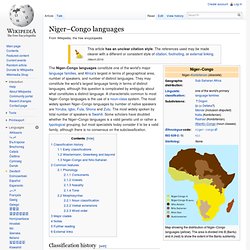
They may constitute the world's largest language family in terms of distinct languages, although this question is complicated by ambiguity about what constitutes a distinct language. A characteristic common to most Niger–Congo languages is the use of a noun-class system. The most widely spoken Niger–Congo languages by number of native speakers are Yoruba, Igbo, Fula, Shona and Zulu. The most widely spoken by total number of speakers is Swahili. Some scholars have doubted whether the Niger–Congo languages is a valid genetic unit or rather a typological grouping, but most specialists today consider it to be a valid family, although there is no consensus on the subclassification. Classification history[edit] Early classifications[edit] Westermann, Greenberg and beyond[edit] Niger–Congo and Nilo-Saharan[edit] Indo-European languages. The Indo-European languages are a family of several hundred related languages and dialects.
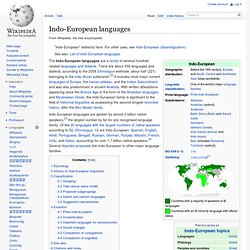
There are about 439 languages and dialects, according to the 2009 Ethnologue estimate, about half (221) belonging to the Indo-Aryan subbranch.[2] It includes most major current languages of Europe, the Iranian plateau, and the Indian Subcontinent, and was also predominant in ancient Anatolia. With written attestations appearing since the Bronze Age in the form of the Anatolian languages and Mycenaean Greek, the Indo-European family is significant to the field of historical linguistics as possessing the second-longest recorded history, after the Afro-Asiatic family.
Indo-European languages are spoken by almost 3 billion native speakers,[3] the largest number by far for any recognised language family. Etymology[edit] Tai-Kadai languages. The Tai–Kadai languages, also known as Daic, Kadai, Kradai, or Kra–Dai, are a language family of highly tonal languages found in southern China and Southeast Asia.
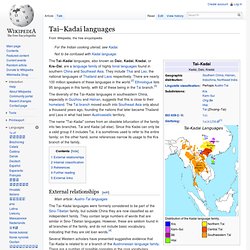
They include Thai and Lao, the national languages of Thailand and Laos respectively. There are nearly 100 million speakers of these languages in the world.[2] Ethnologue lists 95 languages in this family, with 62 of these being in the Tai branch.[3] The diversity of the Tai–Kadai languages in southeastern China, especially in Guizhou and Hainan, suggests that this is close to their homeland. The Tai branch moved south into Southeast Asia only about a thousand years ago, founding the nations that later became Thailand and Laos in what had been Austroasiatic territory. Sino-Tibetan languages. The Sino-Tibetan languages are a family of more than 400 languages spoken in East Asia, Southeast Asia and parts of South Asia.
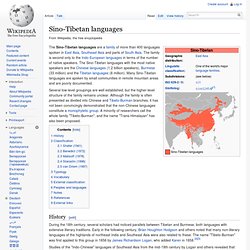
The family is second only to the Indo-European languages in terms of the number of native speakers. The Sino-Tibetan languages with the most native speakers are the Chinese languages (1.2 billion speakers), Burmese (33 million) and the Tibetan languages (8 million). Many Sino-Tibetan languages are spoken by small communities in remote mountain areas and are poorly documented.
Several low-level groupings are well established, but the higher-level structure of the family remains unclear. Although the family is often presented as divided into Chinese and Tibeto-Burman branches, it has not been convincingly demonstrated that the non-Chinese languages constitute a monophyletic group. History[edit] During the 18th century, several scholars had noticed parallels between Tibetan and Burmese, both languages with extensive literary traditions. Paul K. Classification[edit] Afroasiatic languages. Afroasiatic (Afro-Asiatic), also known as Afrasian and traditionally Hamito-Semitic (Chamito-Semitic),[3] is a large language family, of several hundred related languages and dialects.
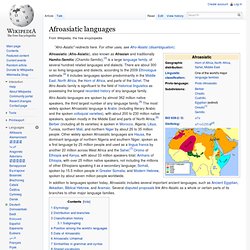
There are about 300 or so living languages and dialects, according to the 2009 Ethnologue estimate.[4] It includes languages spoken predominantly in the Middle East, North Africa, the Horn of Africa, and parts of the Sahel. The Afro-Asiatic family is significant to the field of historical linguistics as possessing the longest recorded history of any language family. In addition to languages spoken today, Afroasiatic includes several important ancient languages, such as Ancient Egyptian, Akkadian, Biblical Hebrew, and Aramaic.
Several disputed proposals link Afro-Asiatic as a whole or certain parts of its branches to other major language families. Etymology[edit] Austronesian languages. The are a language family widely dispersed throughout the islands of Southeast Asia and the Pacific , with a few members spoken on continental Asia that are spoken by about 386 million people. It is on par with Indo-European , Niger–Congo , Afroasiatic and Uralic as one of the best-established ancient language families. Otto Dempwolff , a German scholar, was the first researcher to extensively explore Austronesian using the comparative method . Another German scholar, Wilhelm Schmidt, coined the German word [ 2 ] which comes from Latin "south wind" plus Greek "island".
The name was formed from the same roots. The family is aptly named, as the vast majority of Austronesian languages are spoken on islands: only a few languages, such as Malay and the Chamic languages , are indigenous to mainland Asia. According to Robert Blust (1999), Austronesian is divided in several primary branches, all but one of which are found exclusively on Taiwan. . [ edit ] Structure [ edit ] Lexicon Tsou Saaroa. Dravidian languages. Altaic languages. Altaic (/ælˈteɪɨk/, /ɑːl-/) is a proposed language family that includes the Turkic, Mongolic, Tungusic, Koreanic, and Japonic languages.[1] These languages are spoken in a wide arc stretching from northeast Asia through Central Asia to Anatolia and eastern Europe (Turks, Kalmyks).[2] The group is named after the Altai Mountains, a mountain range in Central Asia.
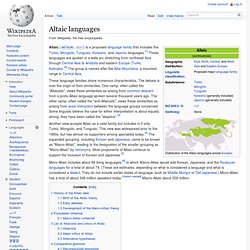
Another view accepts Altaic as a valid family but includes in it only Turkic, Mongolic, and Tungusic. This view was widespread prior to the 1960s, but has almost no supporters among specialists today.[4] The expanded grouping, including Korean and Japanese, came to be known as "Macro-Altaic", leading to the designation of the smaller grouping as "Micro-Altaic" by retronymy. Most proponents of Altaic continue to support the inclusion of Korean and Japanese.[5] Micro-Altaic includes about 66 living languages,[6] to which Macro-Altaic would add Korean, Japanese, and the Ryukyuan languages for a total of about 74. Early debates[edit] Japonic languages. The Japonic language family includes the Japanese language spoken on the main islands of Japan as well as the Ryukyuan languages spoken in the Ryukyu Islands.

The family is widely accepted by linguists, and the term "Japonic languages" was coined by Leon Serafim.[2] The common ancestral language is known as Proto-Japonic.[3] The essential feature of this classification is that the first split in the family resulted in the separation of all dialects of Japanese from all varieties of Ryukyuan. According to Shiro Hattori, this separation occurred during the Yamato period (250–710).[4] Scholarly discussions about the origin of Japonic languages present an unresolved set of related issues.[5] The clearest connections seem to be with toponyms in southern Korea, which may be in Gaya (Kara) or other scarcely attested languages.[6] Members[edit] The Japonic (or Japanese–Ryukyuan) languages are: It is not clear if "pre-Kara" was related to the language of the later Gaya (Kara) confederacy.
Austro-Asiatic languages. Indo-European languages.